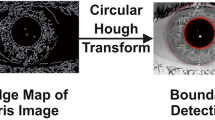Abstract
Iris recognition has an important role in the field of biometrics since mid twentieth century. Among all biometric characteristics, iris is well-known to own a rich, stable and unique set of features. Different features like phase based features, textural features, key point descriptors and zero-crossing representations have been used to carry out iris recognition in the past. In this paper, two prevailing sets of features are combined to be used for iris recognition: first-order and second-order statistical measures as textural feature descriptors. A hybrid statistical dependency based feature selection algorithm is also applied on the extracted feature descriptors to remove noisy and redundant feature, thus reducing the size of feature vector. Back propagation neural network using Levenberg-Marquardt training algorithm is used for recognition task. The proposed iris recognition framework is tested on a well-known iris datasets like CASIA V1, CASIA V3: interval and lamp, and UBIRIS V1 to evaluate the robustness, and showed promising outcomes with the best genuine acceptance rate of 99.38, 99.84, 98.24 and 96.24% for a feature vector of size 13–17.




Similar content being viewed by others
References
Bolle, R.M., et al.: Guide to Biometrics. Springer Science & Business Media, Berlin (2013)
Jain, A.K., Ross, A., Prabhakar, S.: An introduction to biometric recognition. IEEE Trans. Circuits Syst. Video Technol. 14(1), 4–20 (2004)
Daugman, J.: How iris recognition works. IEEE Trans. Circuits Syst. Video Technol. 14(1), 21–30 (2004)
Daugman, J.G., Biometric personal identification system based on iris analysis. Google Patents (1994)
Daugman, J.: New methods in iris recognition. IEEE Trans. Syst. Man Cybern. Part B (Cybernetics). 37(5), 1167–1175 (2007)
Gu, H., Gao, Z., Wu, F.: Selection of optimal features for iris recognition. Adv. Neural Netw.-ISNN 2005, 814–814 (2005)
Proenca, H., Alexandre, L.A.: Iris recognition: measuring feature’s quality for the feature selection in unconstrained image capture environments. In: Proceedings of the IEEE International Conference on Computational Intelligence for Homeland Security and Personal Safety (2006)
Roy, K., Bhattacharya, P.: Optimal features subset selection and classification for iris recognition. J. Image Video Process. 9, 29 (2008)
Wang, L., Sun, Z., Tan, T.: Robust regularized feature selection for iris recognition via linear programming. In: 21st International Conference in Pattern Recognition (ICPR). IEEE (2012)
Chen, Y., et al.: Efficient iris recognition based on optimal sub feature selection and weighted subregion fusion. Sci. World J. 15, 71–73 (2014)
Minaee, S., Abdolrashidi, A., Wang, Y.: Iris recognition using scattering transform and textural features. IEEE Workshop (SP/SPE) in Signal Processing and Signal Processing Education (2015)
Bhateja, A.K., et al.: Iris recognition based on sparse representation and k-nearest subspace with genetic algorithm. Pattern Recognit. Lett. 73, 13–18 (2016)
Nithya, A., Lakshmi, C., Krithiga, R.: Enhanced annular iris recognition using bag of vocabulary models. Int. J. Control Theory Appl. 9(40), 1095–1100 (2016)
Nithya, A., Lakshmi, C.: Towards enhancing non-cooperative iris recognition using improved segmentation methodology for noisy images. J. Artif. Intell. 10, 76–84 (2017)
Proenca, H., Alexandre, L.A.: Iris recognition: an analysis of the aliasing problem in the iris normalization stage. In: IEEE International Conference in Computational Intelligence and Security (2006)
Mehrotra, H., Sa, P.K., Majhi, B.: Fast segmentation and adaptive SURF descriptor for iris recognition. Math. Comput. Modell. 58(1), 132–146 (2013)
Haralick, R.M., Shanmugam, K.: Textural features for image classification. IEEE Trans. Syst. Man Cybernet. 6, 610–621 (1973)
Srinivasan, G., Shobha, G.: Statistical texture analysis. In: Proceedings of World Academy of Science, Engineering and Technology (2008)
Peng, H., Long, F., Ding, C.: Feature selection based on mutual information criteria of max-dependency, max-relevance, and min-redundancy. IEEE Trans. Pattern Anal. Mach. Intell. 27(8), 1226–1238 (2005)
CASIA Database.: http://www.cbsr.ia.ac.cn/english/Databases.asp. Accessed on 2 May 2014
Proença, H., Alexandre, L.A.: UBIRIS: a noisy iris image database. In: Proceedings of the International Conference on Image Analysis and Processing. Springer (2005)
Acknowledgements
The authors would like to thank the Institute of Automation, Chinese Academy of Sciences, Bei**g, China and the SOCIA Lab, University of Beira Interior, Covilhã, Portugal, for their contributions of the databases employed in this work.
Author contributions Alice Nithya, A. developed the SDFS algorithm, performed the data analysis, and wrote the manuscript. Lakshmi, C. advised data analysis and edited the original version of the manuscript.
Author information
Authors and Affiliations
Corresponding author
Ethics declarations
Conflict of interest
The authors declare no conflict of interest.
Rights and permissions
About this article
Cite this article
Nithya, A.A., Lakshmi, C. Enhancing iris recognition framework using feature selection and BPNN. Cluster Comput 22 (Suppl 5), 12363–12372 (2019). https://doi.org/10.1007/s10586-017-1619-4
Received:
Revised:
Accepted:
Published:
Issue Date:
DOI: https://doi.org/10.1007/s10586-017-1619-4




